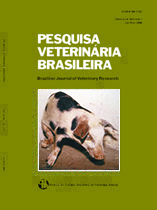 |
|
|
|
Year 2017 - Volume 37, Number 6
|

|
Influence of prolonged flaxseed (Linum usitatissimum) consumption over epididymis and testicle histoarchitecture of Wistar rats, 37(6):650-656
|
ABSTRACT.- Corrêa L.B.N.S., Cardozo L.F.M.F., Ribeiro I.C.A, Boaventura G.T. & Chagas M.A. 2017. Influence of prolonged flaxseed (Linum usitatissimum) consumption over epididymis and testicle histoarchitecture of Wistar rats. Pesquisa Veterinária Brasileira 37(6):650-656. Laboratório de Biomorfologia Celular e Extracelular, Instituto Biomédico, Universidade Federal Fluminense, Rua Prof. Hernani Melo 101, São Domingos, Niterói, RJ 24210-130, Brazil. E-mail: chagas.m@gmail.com
Flaxseed is considered a functional food with several health benefits. However, because of its high phytoestrogen content, flaxseed influences hormone metabolism and affects the gonadal biomorphology. In this study, computerized histomorphometry was used to evaluate seminiferous and epididymal tubules, considering the different regions of the epididymis (head, body and tail) of rats subjected to a prolonged diet of flaxseed. Young adult male Wistar rats (n=20) were divided into 2 groups during their lactation period: Control Group (CG), fed casein-based meals and Flaxseed Group (FG), fed a 25% flaxseed meal. After 250 days of continuous ingestion, the animals were euthanized and a blood sample was collected. The testicles and epididymis were removed and fixed in buffered formalin solution. The samples were subjected to routine histological paraffin techniques and stained with hematoxilin and eosin. Immunostaining was performed using an antivimentin antibody for Sertoli cell identification. For morphometry, images of the slides were scanned and analyzed using Image J to determine the epithelial height, tubular and luminal diameter and tubular and luminal area. In the hormonal evaluation, FG had a higher serum concentration of estrogen (P=0.001), but no change was observed in the concentration of testosterone. The morphometric assay of seminiferous tubules and epididymal regions revealed no significant differences between the analyzed groups. Similarly, Sertoli cell quantification showed no significant differences in the FG (P=0.98). These results revealed that the continuous and prolonged intake of 25% flaxseed meals from gestation to 250 days of age, even with a significant increase in serum levels of estradiol, does not exert adverse effects on the testicular and epididymal structure or on the cells participating in the spermatogenesis of rats. |
| |
|
|
| |
|
 |